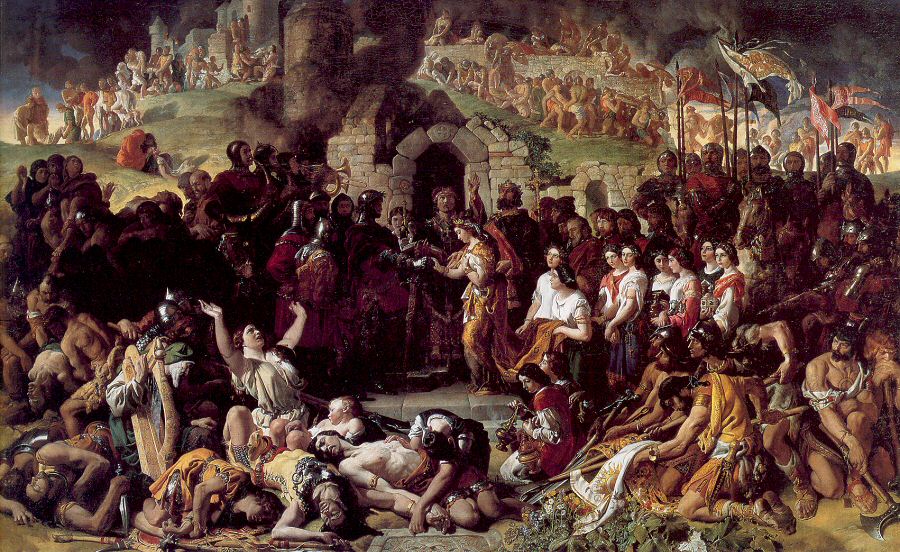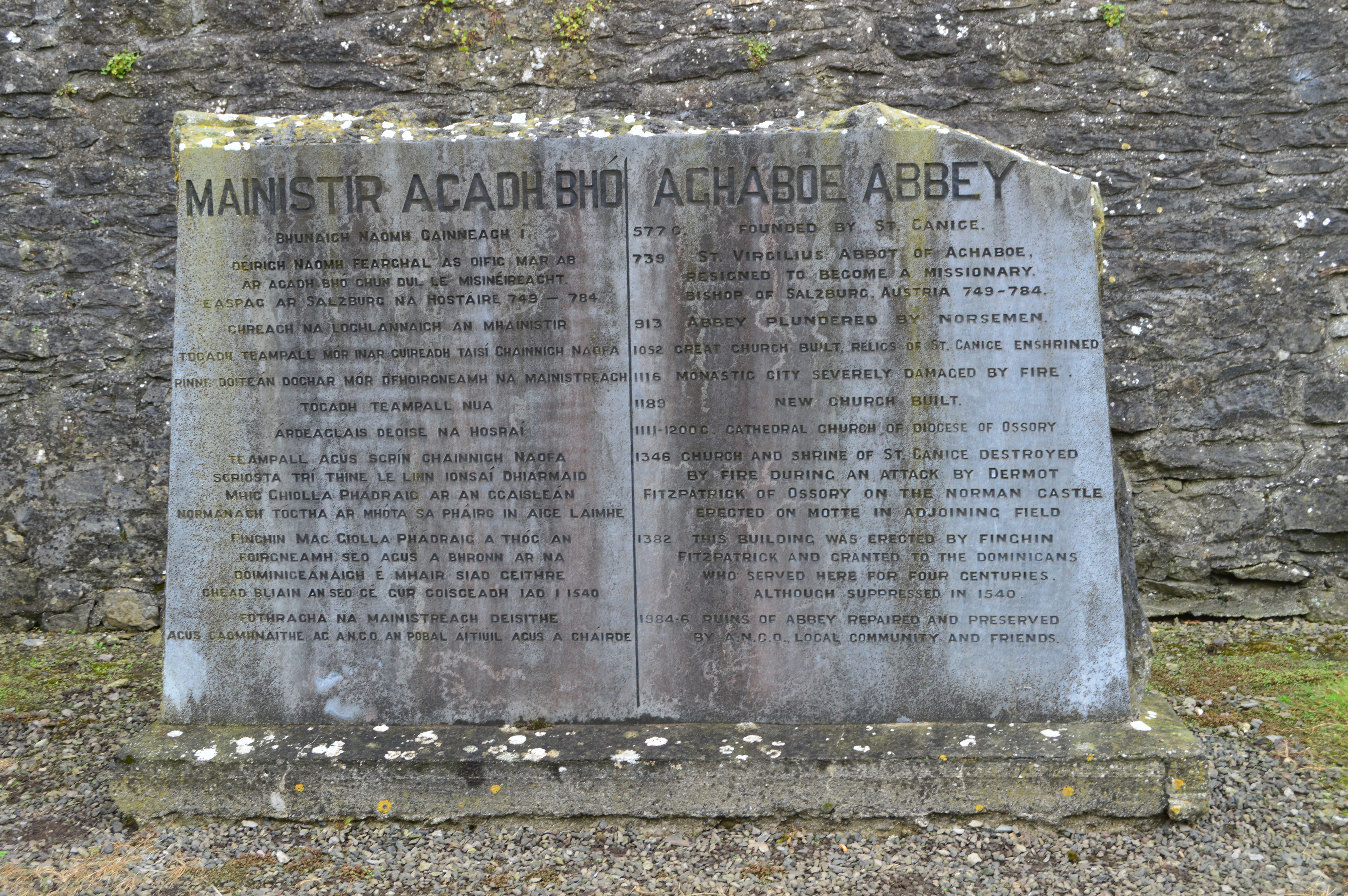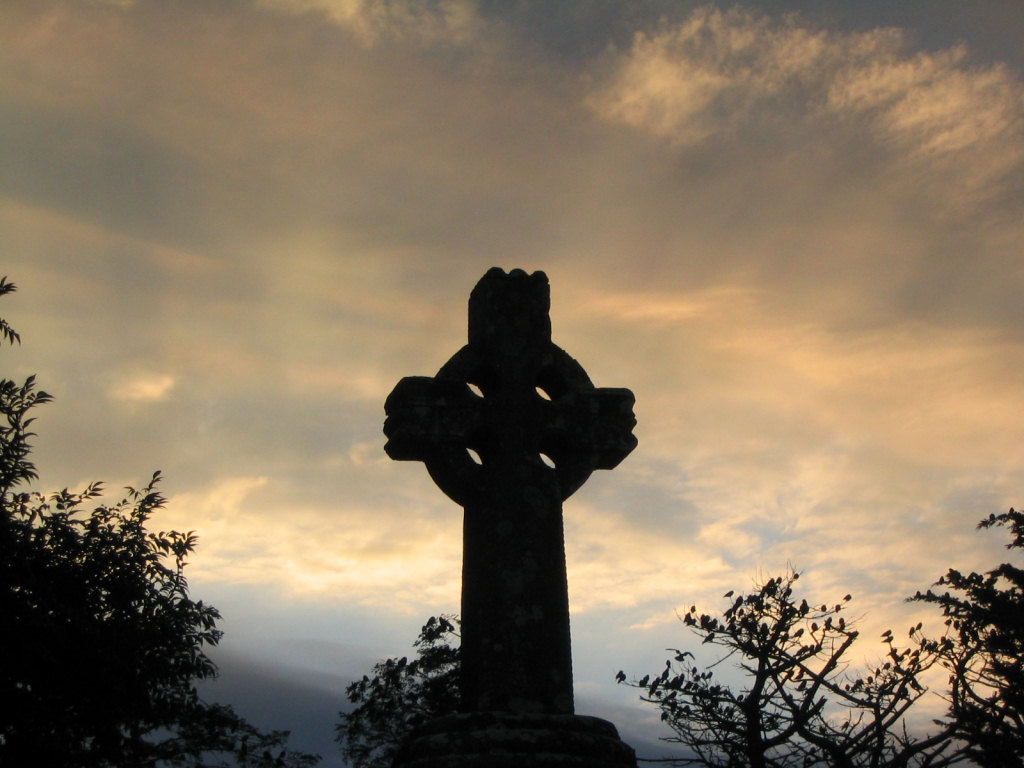|
Saint Canice's Cathedral
St Canice's Cathedral (, ), also known as Kilkenny Cathedral, is a cathedral of the Church of Ireland in Kilkenny city, Ireland. It is in the ecclesiastical province of Dublin. Previously the cathedral of the Diocese of Ossory, it is now one of six cathedrals in the United Dioceses of Cashel and Ossory. History The present building dates from the 13th century and is the second longest cathedral in Ireland, after St Patrick's Cathedral, Dublin. Beside the cathedral stands a 9th-century round tower. St Canice's tower is an example of a well-preserved 9th-century "Celtic Christian" round tower. It is dedicated to St Canice. It is one of only three such medieval round towers in Ireland that can still be climbed to the top, the other two being Kildare Round Tower in Kildare Town and Devenish Round Tower in County Fermanagh. The cathedral stands on the site of a Celtic Christian monastery said to have been founded in the sixth century by St Canice as a daughter house of ... [...More Info...] [...Related Items...] OR: [Wikipedia] [Google] [Baidu] |
County Kilkenny
County Kilkenny () is a Counties of Ireland, county in Republic of Ireland, Ireland. It is in the Provinces of Ireland, province of Leinster and is part of the Southern Region, Ireland, Southern Region. It is named after the City status in Ireland, city of Kilkenny. Kilkenny County Council is the Local government in the Republic of Ireland, local authority for the county. At the 2022 census of Ireland, 2022 census the population of the county was 103,685. The county was based on the historic Gaelic Ireland, Gaelic kingdom of Osraige, Ossory (''Osraighe''), which was coterminous with the Bishop of Ossory, Diocese of Ossory. Geography and subdivisions Kilkenny is the 16th-largest of Ireland's 32 counties by area and the 21st-largest in terms of population. It is the third-largest of Leinster's 12 counties in size, the seventh-largest in terms of population, and has a population density of 50 people per km2. Kilkenny borders five counties – County Tipperary, Tipperary to the we ... [...More Info...] [...Related Items...] OR: [Wikipedia] [Google] [Baidu] |
Kildare Town
Kildare () is a town in County Kildare, Ireland. , its population was 10,302, making it the 7th largest town in County Kildare. It is home to Kildare Cathedral, historically the site of an important abbey said to have been founded by Saint Brigid of Kildare in the 5th century. The Curragh lies east of the town. The town lies on the R445, some west of Dublin – near enough for it to have become, despite being a regional centre in its own right, a commuter town for the capital. Although Kildare gives its name to the county, Naas is the county town. History Founding by Saint Brigid Rich in heritage and history, Kildare Town dates from the 5th century, when it was the site of the original 'Church of the Oak' and monastery founded by Saint Brigid. This became one of the three most important Christian foundations in Celtic Ireland. It was said that Brigid's mother was a Christian and that Brigid was reared in her father's family, that is with the children of his lawful wife. ... [...More Info...] [...Related Items...] OR: [Wikipedia] [Google] [Baidu] |
Kingdom Of Osraige
Osraige (Old Irish) or Osraighe (Classical Irish), OsraĂ (Modern Irish), anglicized as Ossory, was a medieval Irish kingdom comprising what is now County Kilkenny and western County Laois, corresponding to the Roman Catholic Diocese of Ossory, Diocese of Ossory. The home of the Osraige people, it existed from around the first century until the Norman invasion of Ireland in the 12th century. It was ruled by the Dál Birn dynasty, whose medieval descendants assumed the surname Mac Giolla Phádraig. According to tradition, Osraige was founded by Ă“engus Osrithe in the 1st century and was originally within the province of Leinster. In the 5th century, the Corcu LoĂgde of Kingdom of Munster, Munster displaced the Dál Birn and brought Osraige under Munster's direct control. The Dál Birn returned to power in the 7th century, though Osraige remained nominally part of Munster until 859, when it achieved formal independence under the powerful king Cerball mac DĂşnlainge. Osraige's ru ... [...More Info...] [...Related Items...] OR: [Wikipedia] [Google] [Baidu] |
Abbey Church
A church, church building, church house, or chapel is a building used for Christian worship services and Christian activities. The earliest identified Christian church is a house church founded between 233 AD and 256 AD. ''Church'' is also used to describe a body or an assembly of Christian believers, while "the Church" may be used to refer to the worldwide Christian religious community as a whole. In traditional Christian architecture, the plan view of a church often forms a Christian cross with the centre aisle and seating representing the vertical beam and the bema and altar forming the horizontal. Towers or domes may inspire contemplation of the heavens. Modern churches have a variety of architectural styles and layouts. Some buildings designed for other purposes have been converted to churches, while many original church buildings have been put to other uses. From the 11th to the 14th century, there had been a wave of church construction in Western Europe. Many churc ... [...More Info...] [...Related Items...] OR: [Wikipedia] [Google] [Baidu] |
Kingdom Of Ossory
Osraige (Old Irish) or Osraighe (Classical Irish), OsraĂ (Modern Irish), anglicized as Ossory, was a medieval Irish kingdom comprising what is now County Kilkenny and western County Laois, corresponding to the Diocese of Ossory. The home of the Osraige people, it existed from around the first century until the Norman invasion of Ireland in the 12th century. It was ruled by the Dál Birn dynasty, whose medieval descendants assumed the surname Mac Giolla Phádraig. According to tradition, Osraige was founded by Ă“engus Osrithe in the 1st century and was originally within the province of Leinster. In the 5th century, the Corcu LoĂgde of Munster displaced the Dál Birn and brought Osraige under Munster's direct control. The Dál Birn returned to power in the 7th century, though Osraige remained nominally part of Munster until 859, when it achieved formal independence under the powerful king Cerball mac DĂşnlainge. Osraige's rulers remained major players in Irish politics for ... [...More Info...] [...Related Items...] OR: [Wikipedia] [Google] [Baidu] |
Episcopal See
An episcopal see is the area of a bishop's ecclesiastical jurisdiction. Phrases concerning actions occurring within or outside an episcopal see are indicative of the geographical significance of the term, making it synonymous with ''diocese''. The word ''see'' is derived from Latin , which in its original or proper sense denotes the seat or chair that, in the case of a bishop, is the earliest symbol of the bishop's authority. This symbolic chair is also known as the bishop's . The church in which it is placed is for that reason called the bishop's cathedral, from Latin , meaning the 'church of the '. The word ''throne'' is also used, especially in the Eastern Orthodox Church, both for the chair and for the area of ecclesiastical jurisdiction. The term ''see'' is also used of the town where the cathedral or the bishop's residence is located. Catholic Church Within Catholicism, each diocese is considered to be a see unto itself with a certain allegiance to the See of Rome. ... [...More Info...] [...Related Items...] OR: [Wikipedia] [Google] [Baidu] |
Synod Of Rathbreasail
A synod () is a council of a Christian denomination, usually convened to decide an issue of doctrine, administration or application. The word ''synod'' comes from the Ancient Greek () ; the term is analogous with the Latin word . Originally, synods were meetings of bishops, and the word is still used in that sense in Catholicism, Oriental Orthodoxy and Eastern Orthodoxy. In modern usage, the word often refers to the governing body of a particular church, whether its members are meeting or not. It is also sometimes used to refer to a church that is governed by a synod. Sometimes the phrase "general synod" or "general council" refers to an ecumenical council. The word ''synod'' also refers to the standing council of high-ranking bishops governing some of the autocephalous Eastern Orthodox and Oriental Orthodox churches. Similarly, the day-to-day governance of patriarchal and major archiepiscopal Eastern Catholic Churches is entrusted to a permanent synod. Usages in different ... [...More Info...] [...Related Items...] OR: [Wikipedia] [Google] [Baidu] |
Aghaboe Abbey
The Abbey of Aghaboe is one of the most important of the abbeys and priories in County Laois. It was founded in the kingdom of Osraige by St. Canice in the 6th century. In his ''Vita Sancti Columbae'' (Life of St. Columba), Adomnán refers to the abbey, saying that its name means a (little field) of the cow: "''quod Latine Campulus Bovis dicitur, Scotice vero Achadh-bou''" History The abbey grew into a major centre of learning, commerce and agriculture. Among the monks from the abbey was St. Virgilius (Feargal or Farrell), a noted geometer and astronomer who was abbot before he left Ireland and built the cathedral at Salzburg in Austria in the 8th century."Aghaboe Abbey", Laois County Council He was canonized in 1233. The |
Daughter House
A dependency, among monastic orders, denotes the relation of a monastic community with a newer community that it has founded elsewhere. The relationship is that of the founding abbey or conventual priory, termed the motherhouse, with a monastery composed of the monks or nuns of the new community, which is called the daughter house. In that situation, the abbot or abbess (or prior or prioress in those monastic congregations which do not have abbots or abbesses) remains the ultimate authority for the affairs of the dependent priory, which is considered an extension of the founding house. This relationship will end at such time as the new community becomes fully autonomous in its own right. Bonds Monasteries of nuns can make a bond with a monastery of monks or friars, preferably within the same congregation or order, whereby the two are affiliated, and the fathers guarantee pastoral care to the nuns. In this sense, the women's house is considered a dependency on that of the men for ... [...More Info...] [...Related Items...] OR: [Wikipedia] [Google] [Baidu] |
St Canice
Cainnech of Aghaboe (515/16–600), also known as Saint Canice in Ireland, Saint Kenneth in Scotland, Saint Kenny and in Latin Sanctus Canicus, was an Irish abbot, monastic founder, priest and missionary during the early medieval period. Cainnech is one of the Twelve Apostles of Ireland and preached Christianity across Ireland and to the Picts in Scotland. He wrote a commentary on the Gospels, which for centuries was known as the ''Glas-Choinnigh'' or ''Kenneth's Lock'' or the ''Chain of Cainnech''. Most of what is written about Cainnech's life is based on tradition, however he was considered a man of virtue, great eloquence and learning. His feast day is commemorated on 11 October in the Roman Catholic Church and the Eastern Orthodox Church according to their respective calendars (Gregorian or Church Julian) with additional feast days on 1st or 14 August in the Eastern Orthodox Church. Introduction A lot of what is known of Cainnech comes from legend. However, he is docum ... [...More Info...] [...Related Items...] OR: [Wikipedia] [Google] [Baidu] |
Celtic Christian Monastery
Celtic Christianity is a form of Christianity that was common, or held to be common, across the Celtic-speaking world during the Early Middle Ages. The term Celtic Church is deprecated by many historians as it implies a unified and identifiable entity entirely separate from that of mainstream Western Christendom. For this reason, many prefer the term Insular Christianity. As Patrick Wormald explained, "One of the common misconceptions is that there was a ''Roman'' Church to which the ''Celtic'' Church was nationally opposed." Some writers have described a distinct "Celtic Church" uniting the Celtic peoples and distinguishing them from adherents of the Roman Church, while others classify Celtic Christianity as a set of distinctive practices occurring in those areas. Varying scholars reject the former notion, but note that there were certain traditions and practices present in both the Irish and British churches that were not seen in the wider Christian world. Such practices i ... [...More Info...] [...Related Items...] OR: [Wikipedia] [Google] [Baidu] |
Oxford
Oxford () is a City status in the United Kingdom, cathedral city and non-metropolitan district in Oxfordshire, England, of which it is the county town. The city is home to the University of Oxford, the List of oldest universities in continuous operation, oldest university in the English-speaking world; it has buildings in every style of Architecture of England, English architecture since late History of Anglo-Saxon England, Anglo-Saxon. Oxford's industries include motor manufacturing, education, publishing, science, and information technologies. Founded in the 8th century, it was granted city status in 1542. The city is located at the confluence of the rivers Thames (locally known as the Isis) and River Cherwell, Cherwell. It had a population of in . It is north-west of London, south-east of Birmingham and north-east of Bristol. History The history of Oxford in England dates back to its original settlement in the History of Anglo-Saxon England, Saxon period. The name †... [...More Info...] [...Related Items...] OR: [Wikipedia] [Google] [Baidu] |









